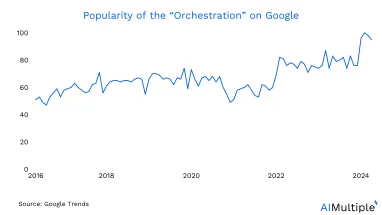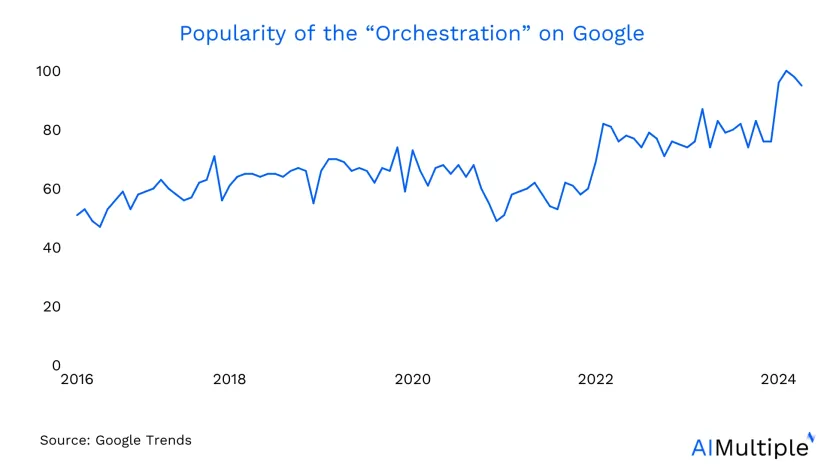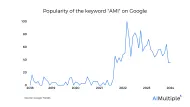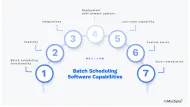Guide to IT Orchestration: Benefits, Use Cases & Tools in 2024


Businesses need to streamline processes and implement digital transformation strategies. IT orchestration is a vital asset that can help businesses during their digital transformation by automating the configuration, coordination, and management of computer systems and software.
This article is an in-depth guide to orchestration outlining its benefits and use cases.
What is an orchestration tool?
Orchestration tools are a type of software that can automate the configuration, coordination, integration, and data management processes on several applications and systems. IT teams leverage orchestration tools to automate repetitive tasks in these processes such as server provisioning, incident management, cloud orchestration, database management, application orchestration, and many other tasks and workflows.
What is the difference between IT automation and orchestration?
IT automation refers to the practice of using programmed scripts or RPA bots to perform a sequence of moves to complete a certain IT task (e.g. software update), whereas IT orchestration refers to automating multiple tasks on one or multiple platforms (e.g. multiple server management) using workload automation software, and job schedulers. Therefore, orchestration can be thought of as an end-to-end workflow automation solution.
What are the benefits of IT orchestration?
Orchestration offers multiple benefits to IT teams, such as:
- Centralized management: Orchestration enables IT teams to automate tasks across multiple platforms from a single point, which provides centralized monitoring and management over all IT servers, applications, and workflows.
- Fast and easy integrations: Centralized coordination among IT servers and applications enables easier and faster integration of new tools and systems to the existing infrastructure.
- Reduced product-release cycles: Coordinating IT workflows such as DevOps and automation testing enables faster time to release new products and applications.
Where is orchestration used?
Orchestration is used for:
1. Unified IT workflow automation
Orchestration tools enable scheduling and execution of IT jobs and workflows across multiple platforms, as well as initiating workflows at triggering events, thus, automating repetitive IT process workflows.
2. DevOps orchestration
DevOps is the set of practices that combines software development and IT operations in order to reduce software development lifecycle (SDLC). Orchestration tools enhance DevOps lifecycles by:
- Automating IT processes relevant to DevOps, such as machine provisioning, system reboots, or task scheduling
- Auto reporting of process errors, fails, and interruptions
- Creating a product backlog and revision history for audit and compliance
3. Cloud orchestration
Cloud orchestration is the practice of automating cloud-related tasks, including:
- provisioning and de-provisioning of virtual machines on multiple clouds
- provisioning storage capacity
Orchestration provides enhanced management of connections and operations of workloads on private and public clouds.
What are the tools used for orchestration?
Depending on the tasks and workflows, businesses can leverage the following types of tools and software for orchestration:
- Job schedulers: Job schedulers are tools that businesses use to schedule the initiation of workflows by creating queues of tasks, assigning tasks to servers, and monitoring the execution.
- Workload automation (WLA) tools: WLA tools enable the automation of several back-end workflows by scheduling, triggering, and executing processes on multiple platforms. The difference between WLA tools and job schedulers is that job schedulers typically do not incorporate triggering events (e.g. run tasks based on set times instead of triggering events)
- MFT solutions: MFT (Managed File Transfer) solutions are software platforms that facilitate secure, reliable, and efficient file transfer within an organization or between external partners. They typically offer features such as encryption, automation, and audit trails to ensure compliance and data integrity. These solutions are great alternatives to WLA tools if the business only needs complex file transfers.
Note that job schedulers and WLA are different tools. Learn more about differences between job schedulers vs. WLA.
Compare top orchestration tools based on user reviews, scores and features.
Major types of orchestration
Orchestration is an umbrella term covering sub-categories, technologies and tools, such as:
| Type of orchestration | Main focus | Key technologies | Common use cases |
|---|---|---|---|
| Container Orchestration | Managing containerized apps | Container Orchestration Tools | Scaling containerized apps, managing container clusters |
| Cloud Orchestration | Managing cloud resources | Cloud Automation Tools | Deploying cloud infrastructure, managing cloud resources |
| Data Orchestration | Coordination of data workflows | ETL tools, Workflow Orchestration | ETL processes, data pipelines, data management |
| ETL Orchestration | Extraction, transformation, loading of data | ETL Tools | Data warehousing, data transformation, data integration |
| Infrastructure Orchestration | Automation of infrastructure | Infrastructure as Code (IaC) | Automating infrastructure setup, cloud provisioning |
| IT Orchestration | Automation in IT operations | Scripts, Configuration Management | Automating IT tasks, managing IT resources |
| Process Orchestration | Workflow automation | Business Process Management (BPM) | Business process automation, task coordination |
| Security Orchestration | Automation of security tasks | Security Orchestration and Response (SOAR) | Security automation, incident response, threat intelligence |
| Service Orchestration | Coordination of services | Microservices, APIs, ESB | Integrating different services, creating service-based workflows |
Service Orchestration
Service orchestration involves orchestrating services across multiple systems to perform specific business functions. This process uses automation tools to create workflows that connect disparate tools through a single API. It reduces the need for human intervention, allowing automation tasks to be executed efficiently. By integrating various services, service orchestration creates automated workflows to streamline tasks and processes. This leads to cost savings and increased agility, benefiting both technical and business users. Most companies use service orchestration to enhance their ability to manage connections between applications, creating a larger workflow that improves overall business operations.
How does service orchestration work?
Service orchestration focuses on integrating various services through automation tools and creating workflows. It hints at the use of APIs and microservices but does not explicitly describe how orchestration operates at a technical level.
Process Orchestration
Process orchestration is about automating tasks and processes within a larger business context. It uses automation tools to create workflows that coordinate individual tasks. This process often spans multiple computer systems, allowing for seamless integration across various platforms. Business users can use process orchestration to reduce the need for manual intervention, leading to improved efficiency. By automating specific business functions, process orchestration helps businesses save time and resources. It can also be used to ensure compliance with security protocols and manage connections to external databases to maintain data integrity across multiple systems.
How does process orchestration work?
It describes automating tasks and processes across multiple systems, but could provide more specifics about how business process management (BPM) or other tools create these workflows.
IT Orchestration
IT orchestration focuses on automating IT tasks and processes, including application deployment, system configuration, and infrastructure management. It uses automation tools to reduce manual labor and human error, especially in data centers with multiple computer systems. IT orchestration plays a vital role in ensuring that key IT operations are completed efficiently, with minimal human intervention. This approach aligns with a DevOps approach, enabling IT teams to manage infrastructure and orchestrate services across the enterprise. It also helps manage connections between various operating systems and other technologies, providing a consistent framework for IT operations.
How does IT orchestration work?
IT orchestration describes the focus on automation in IT operations but could explain more about how scripts or configuration management tools work in orchestrating IT processes.
Container Orchestration
Container orchestration is designed to manage containerized applications at scale, often across hybrid clouds. It focuses on automated workflows for deploying, scaling, and maintaining container-based workloads. Container orchestration uses automation tools to coordinate tasks, allowing for the automatic deployment of containerized applications across multiple systems. This approach reduces operational overhead and supports a DevOps approach, providing flexibility in handling the increasing complexity of modern software applications. Container orchestration also helps companies achieve cost savings by optimizing resource allocation and reducing manual intervention in application deployment and maintenance processes.
How does container orchestration work?
Container orchestration focuses on automated workflows to deploy and manage containerized applications, often using tools like Kubernetes or Docker Swarm, allowing for operation across hybrid cloud environments.
Cloud Orchestration
Cloud orchestration focuses on managing resources across cloud environments, focusing on automated workflows to reduce manual effort and ensure efficient operations. It coordinates resources across hybrid clouds, providing a seamless experience for users. Cloud orchestration tools allow organizations to automatically perform tasks that would otherwise require significant human intervention. This type of orchestration ensures compliance with security protocols and facilitates the management of connections between multiple systems. It is crucial for most companies seeking to deploy cloud-based applications and maintain a scalable infrastructure. Cloud orchestration software also supports cost savings through optimized resource allocation.
How does cloud orchestration work?
Cloud orchestration coordinates resources across hybrid clouds, allowing automated workflows for managing cloud resources and reducing manual effort. It requires orchestration tools like AWS CloudFormation or Terraform for efficient operations.
Data Orchestration
Data orchestration coordinates data workflows to manage connections across multiple systems. It uses automation tools to streamline tasks and processes involved in extracting, transforming, and loading data (ETL). Data orchestration enables business users to create automated workflows for data processing without extensive manual intervention. It is particularly useful in environments with increasing complexity, where disparate data sources must be integrated into a cohesive system. This approach helps businesses ensure data consistency, accuracy, and reliability while reducing the need for manual tasks. Data orchestration also plays a significant role in maintaining key metrics for business intelligence and analytics.
How does data orchestration work?
Data orchestration involves automating data workflows with ETL processes, coordinating data extraction, transformation, and loading, while managing connections with external databases.
Infrastructure Orchestration
Infrastructure orchestration focuses on automated workflows for infrastructure setup and management. It uses automation tools like Infrastructure as Code (IaC) to reduce the need for manual intervention in application deployment and system configuration. Infrastructure orchestration allows teams to automatically perform complex tasks, making it easier to maintain infrastructure across multiple computer systems and data centers. This type of orchestration is essential for companies adopting a DevOps approach to streamline their infrastructure management. It also helps reduce operational costs and improves consistency by providing a uniform framework for deploying and managing infrastructure resources.
How does infrastructure orchestration work?
Infrastructure orchestration focuses on automated workflows for infrastructure setup and management. It uses Infrastructure as Code (IaC) to automate complex tasks and manage infrastructure across multiple computer systems and data centers.
Security Orchestration
Security orchestration automates security tasks to improve response times and reduce human intervention. It uses automation tools to create automated workflows that address security incidents and threats. Security orchestration involves orchestrating security protocols across multiple systems, often using Security Orchestration, Automation, and Response (SOAR) tools. This approach allows organizations to automatically perform specific security tasks, ensuring quick responses to potential threats. By orchestrating security, businesses can reduce the workload on security teams and enhance overall security posture. Security orchestration is especially valuable in complex IT environments where threats evolve rapidly, providing a robust defense against cyber risks.
How does security orchestration work?
Security orchestration involves automating security tasks, focusing on creating automated workflows to address security incidents and threats, often using SOAR tools for rapid response.
Further reading
To learn more about automation and orchestration of IT processes, feel free to read our articles:
- In-depth guide to IT process automation (ITPA) and 10 ITPA use cases
- 14 workload automation use cases
- Guide to data management & AI implementation
Check our data-driven automation hub where we keep comprehensive up-to-date lists of top tools and vendors.
To gain a more comprehensive overview of workload automation, download our whitepaper on the topic:
And let us guide you through the process:

Cem is the principal analyst at AIMultiple since 2017. AIMultiple informs hundreds of thousands of businesses (as per Similarweb) including 60% of Fortune 500 every month.
Cem's work has been cited by leading global publications including Business Insider, Forbes, Washington Post, global firms like Deloitte, HPE, NGOs like World Economic Forum and supranational organizations like European Commission. You can see more reputable companies and media that referenced AIMultiple.
Throughout his career, Cem served as a tech consultant, tech buyer and tech entrepreneur. He advised enterprises on their technology decisions at McKinsey & Company and Altman Solon for more than a decade. He also published a McKinsey report on digitalization.
He led technology strategy and procurement of a telco while reporting to the CEO. He has also led commercial growth of deep tech company Hypatos that reached a 7 digit annual recurring revenue and a 9 digit valuation from 0 within 2 years. Cem's work in Hypatos was covered by leading technology publications like TechCrunch and Business Insider.
Cem regularly speaks at international technology conferences. He graduated from Bogazici University as a computer engineer and holds an MBA from Columbia Business School.
Sources:
AIMultiple.com Traffic Analytics, Ranking & Audience, Similarweb.
Why Microsoft, IBM, and Google Are Ramping up Efforts on AI Ethics, Business Insider.
Microsoft invests $1 billion in OpenAI to pursue artificial intelligence that’s smarter than we are, Washington Post.
Data management barriers to AI success, Deloitte.
Empowering AI Leadership: AI C-Suite Toolkit, World Economic Forum.
Science, Research and Innovation Performance of the EU, European Commission.
Public-sector digitization: The trillion-dollar challenge, McKinsey & Company.
Hypatos gets $11.8M for a deep learning approach to document processing, TechCrunch.
We got an exclusive look at the pitch deck AI startup Hypatos used to raise $11 million, Business Insider.
To stay up-to-date on B2B tech & accelerate your enterprise:
Follow on


Comments
Your email address will not be published. All fields are required.